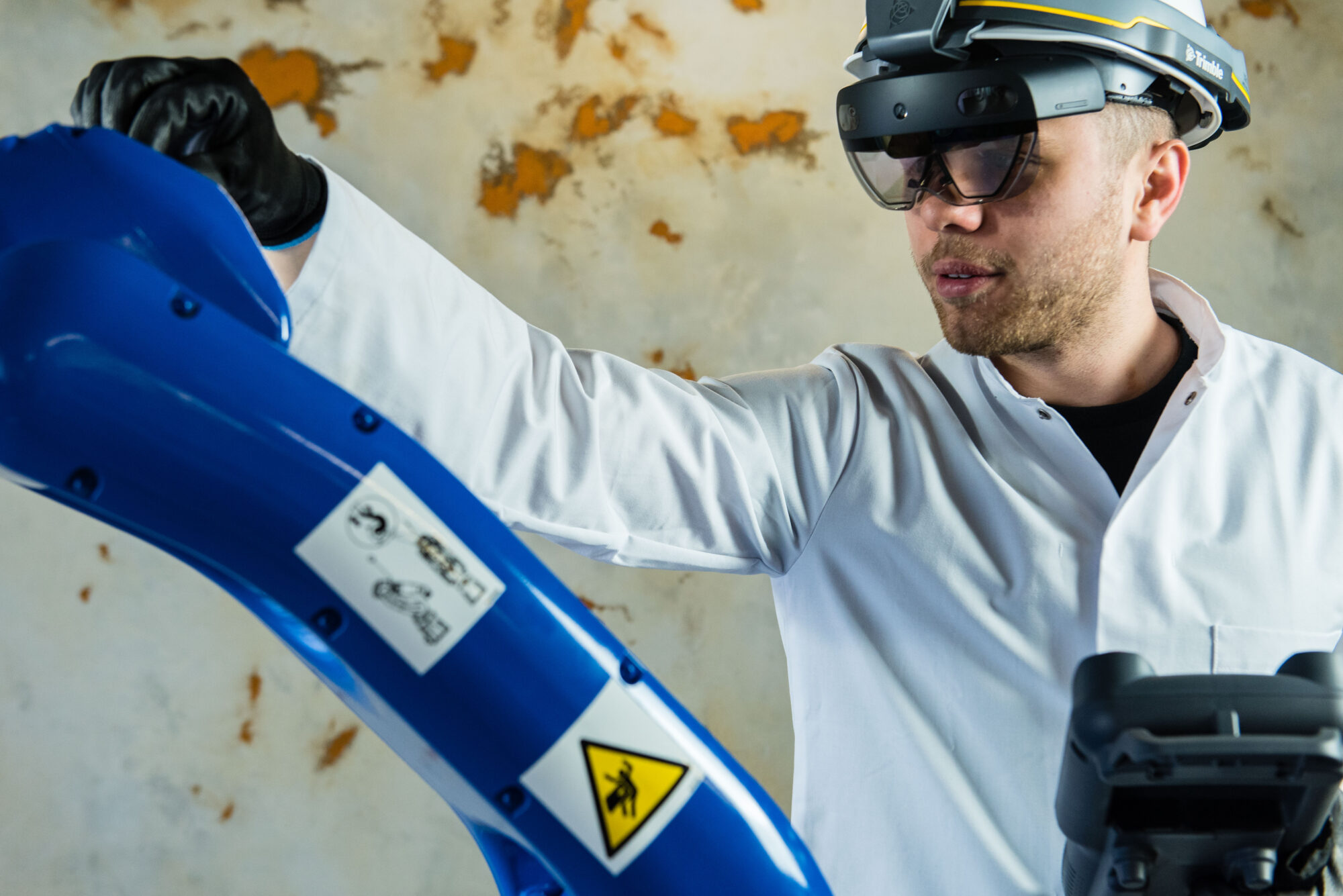Augmented reality remote assistance
What is remote assistance? Augmented Reality (AR) Remote Assistance is a tech solution enhancing real-time communication by overlaying digital information onto the user’s physical environment. It facilitates a virtual collaboration between users, where an expert can guide a remote user to perform tasks by sharing interactive AR annotations on their live video stream. This technology reduces the need for physical presence to troubleshoot problems, decreasing travel time and costs, while increasing efficiency and productivity. It makes specialist knowledge more accessible, even from a distance, and is used in various sectors like healthcare, automotive, manufacturing, and oil&gas. Its potential in bridging physical gaps, enhancing the remote support experience, and promoting hands-on learning marks a significant stride in how we interact with and leverage technology.
Significance of AR remote assistance in revolutionizing remote support
The significance of AR Remote Assistance in revolutionizing remote support is not to be overlooked. This technology, through offering an immersive and interactive method of communication, transforms the way support and guidance are provided. It allows experts to “reach out” and assist users in real-time, reducing miscommunication and accelerating problem resolution, providing support in the assisted reality. This means that instead of lengthy, descriptive explanations or drawn-out written instructions, the support is visual, direct, and contextual. The ability to overlay digital annotations, instructions, or even 3D models onto the real-world view of the remote user significantly enhances the clarity of communication and guidance. This not only leads to more effective and efficient support but also empowers users to solve complex problems with confidence. As a result, augmented reality Remote Assistance drives a substantial improvement in service quality, speed, and overall user satisfaction.
How AR Remote Assistance works
The technology behind AR support is a combination of AR technology and communication tools. It leverages computer vision, image recognition, and 3D modeling to overlay digital information onto the real-world environment. Typically, a user captures their surroundings using a camera-equipped device, such as a smartphone, tablet, or AR glasses.
The software recognizes the scene, anchors digital objects into the real world, and allows the remote expert to interact with these objects in real-time. The expert can draw, annotate, or even superimpose 3D models onto the user’s view, providing precise guidance to resolve the issue at hand.
The key components of AR Remote Assistance include a camera-equipped device, a robust software platform, and a reliable internet connection. The device, often a smartphone, tablet, or AR glasses, captures the real-world view and displays the augmented content to the user. The AR software platform provides tools for real-time communication, annotation, and sometimes even 3D model overlay. It enables the expert to see the user’s view, interact with it virtually, and guide the user through the task. Lastly, a reliable internet connection is crucial for real-time communication and the smooth operation of the system.
Some systems may also incorporate advanced features such as spatial audio, object recognition, and artificial intelligence to further enhance the augmented reality Remote Assistance experience. The integration of these components provides a comprehensive and effective solution for remote support, redefining the boundaries of what’s possible in remote assistance.
Integrating AR Remote Assistance into existing support systems involves a systematic approach. The first step typically involves identifying the specific needs and objectives of the organization, and how AR can address them. This could range from reducing downtime, improving service quality, to expanding the reach of expert support. Following this, an appropriate AR platform that aligns with these requirements needs to be selected. Once the platform is chosen, it’s crucial to prepare the infrastructure for AR support deployment, which may include procuring necessary hardware, ensuring reliable internet connectivity, and setting up the AR software on the devices. Training the support staff and end-users to use the AR system effectively is the next critical step. It’s also recommended to start with a pilot project to evaluate the system’s effectiveness before full-scale implementation. Regular feedback and iteration cycles are crucial to ensure the system continues to meet its objectives and provide value.
Several key factors should be considered when choosing an AR Remote Assistance platform. One of the foremost is the platform’s ease of use, as it should be user-friendly and intuitive for both experts and remote users. The platform’s compatibility with existing hardware, software, and network infrastructure is another important consideration. It’s also vital to check the platform’s features, such as the quality of video streaming, the ability to overlay instructions or 3D models, and support for session recording. Security and compliance with industry standards should be a top priority, as the platform will handle potentially sensitive information. Last but not least, the platform’s scalability and adaptability to future needs is a crucial factor to ensure the investment remains valuable in the long run. By considering these factors, organizations can make a more informed decision and choose a platform that best aligns with their requirements and goals.

presentation to try
Nsflow in action
The potential benefits of AR remote assistance: time-saving and efficiency-boosting
Instead of depending on verbal descriptions or back-and-forth email conversations, the expert can see the issue in the user’s environment, interact with it virtually, and guide the user through the necessary steps to resolve it. This immediacy and clarity of communication can dramatically reduce the time to diagnose and resolve problems.
Nsflow provides an innovative AR-based remote support solution, designed to facilitate more efficient and effective collaboration and problem-solving in real-time. The benefits of this solution are manifold, providing a significant improvement over traditional remote support methods:
– the technology allows experts to provide precise guidance remotely, saving time and costs associated with on-site visits. Experts can view and interact with the problem at hand directly through the user’s camera, eliminating misunderstandings that could arise from verbal or written descriptions.
– the remote support solution improves operational efficiency by reducing downtime. Quick response and resolution times mean that operations can return to normal faster, boosting overall productivity. The solution also has a direct impact on reducing costs, as less time and resources are needed to resolve issues.
– the solution enhances the quality of service, leading to higher customer satisfaction. The real-time, visual, and interactive nature of the support provided not only helps in resolving issues more effectively but also makes the support experience more engaging and satisfactory for the users.
– the platform is user-friendly and doesn’t require any special hardware, which makes it easier to adopt and integrate into existing systems. It also includes features for recording sessions, providing an invaluable resource for training and future reference.
From streamlining operations and reducing costs to improving service quality and customer satisfaction, the AR-powered remote support solution transforms the landscape of remote assistance across industries.
Understanding Remote Assistance
The concept of remote assistance refers to the provision of guidance or support from a distance, without the necessity of being physically present at the location of the issue. In the context of manufacturing and industrial companies, it typically involves technical experts assisting on-site workers to troubleshoot equipment, maintain machinery, or resolve complex operational problems. The key feature of remote assistance is its capacity to provide immediate, expert support, regardless of geographic limitations, ensuring smoother operations and minimal downtime.
Traditional methods of remote assistance primarily include phone calls, emails, or video conferencing, wherein an expert attempts to provide directions based on verbal or written descriptions of the issue. These methods, however, often fall short of providing clear and precise guidance due to the lack of a shared visual context. This often leads to miscommunication, and longer resolution times, and may even exacerbate the problem at hand. AR Remote Assistance, on the other hand, has significantly transformed this paradigm. It employs advanced technologies to overlay digital information onto the real-world view of the on-site worker, enabling the expert to ‘see’ the problem in real-time and provide visual, contextual guidance. This technology bridges the gap between verbal and visual communication, making remote assistance more effective and efficient. It minimizes downtime, increases productivity, and can dramatically enhance the performance of manufacturing and industrial companies. Moreover, augmented reality Remote Assistance enables an expert to assist multiple sites in a day, something impossible with traditional methods. Therefore, AR Remote Assistance not only streamlines the process of troubleshooting but also redefines the potential of remote support in the industrial sector.
The role of AR in remote support is transformative, paving the way for more effective and efficient assistance. It enhances the support experience by blending the digital and physical worlds, providing a visual platform for communication. This can dramatically improve the understanding of complex tasks and processes. AR allows experts to see the on-site issues in real-time, annotate on the live video stream, and guide the remote users with precise, contextual instructions overlaid on their physical environment. This level of interactive and intuitive guidance can significantly reduce errors and miscommunication often associated with traditional forms of remote support. Additionally, by making expert knowledge more accessible, AR can empower on-site personnel to perform tasks beyond their training level, reducing the dependence on specialized technicians.
Thus, AR Remote Assistance holds the key to unlocking the next level of remote support, redefining the boundaries of what is achievable in this realm.


